When I first went to buy watercolor paper I had no clue what paper I needed to use. When confronted by all the terms I was completely confused. Which was best? How did all these things affect my art? After a chat with the salesperson, I did at least have surface knowledge. But it’s not really enough. Even online stores don’t give you enough information. So I thought I’d share what I learned here to make it easier.
Watercolor paper comes in different weights & surfaces 90lb, 140lb, 300lb & smooth, medium, and rough texture. It comes in HOT and cold-pressed (NOT), pulp, or cotton. The watercolor paper you use depends on what you paint, your preferences & budget. If in doubt use 140lb cotton cold pressed paper.
I break down the different parts of choosing a watercolor paper. Also, why you might pick a particular watercolor paper to use over the others. This way when you go online or to the store to choose your watercolor paper you will know exactly why you are getting that one and not just blindly getting it because someone said it was a good idea.
Which Watercolor Paper Should You Use?

There is no right or wrong watercolor paper just what’s right or wrong for you. Although there are good and poor quality papers. You choose the watercolor paper that is the one best designed for your needs. It’s quite possible that in time you will decide on a favorite but equally possible that you may prefer different ones for different artwork.
This is why in spite of recommending that you start out with a good all-rounder like 140lb, cold-pressed cotton watercolor paper, I wanted to explain all the differences and how they affect your painting. It really only boils down to a small number of things to remember. Once you have those you can easily decide for yourself.
You can buy watercolor paper in different sizes, weights, textures, and formats. This can get really confusing really fast. But it needn’t be if you break it down as I have done here.
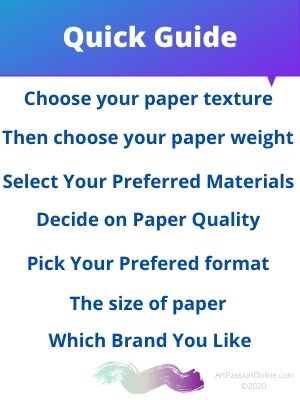
Of course, this is a basic chart. Each area needs more information, which I have shared below.
If you break it down into each of these areas you can pick which watercolor paper you use with confidence. There may be other things some people would like to know as well such as brand, which I have covered in detail under another article: what brand of watercolor is best.
Which Watercolor Paper Texture Is Best To Use
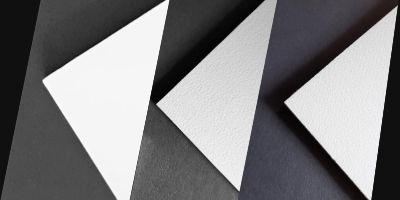
Watercolor paper comes in different presses. These create different textures.
These are
- smooth
- textured
- rough
These papers are called hot-pressed (HP), cold-pressed (NOT), and rough papers. Each one is used for different purposes and reacts differently to the watercolor paints.
These papers can be machine, hand or cylinder pressed.
Hot Pressed Watercolor Paper

Hot pressed watercolor paper (HP) is the smoothest surface to work on. It has very little if any texture.
Hot pressed paper is made by pressing the paper with heat. This gives the paper its smooth surface.
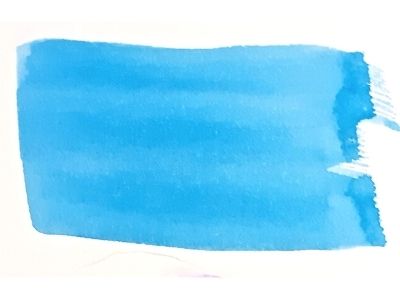
I took 3 pieces of paper, one of each type, and painted a block of color using a flat brush. This is tubed turquoise on Hot Pressed Paper. I mixed one batch and used the same brush and paint for each sample.
You can see how smooth the paper is by how little rippling there is in the surface of the paint.
The Pluses, Minuses & When To Use Hot Pressed Watercolor Paper
- Hot pressed paper is perfect for artists that like to create detailed work. Many illustrators and botanical artists like to use hot-pressed paper. Although, I have come across some that prefer the texture and use cold-pressed paper.
- It is perfect if you need to lift off your colors (depending on the quality of your paper).
- Any grain in the paper will be more evenly distributed because of its lack of texture.
- HOT pressed paper dries more slowly than either cold-pressed or rough paper. The paint stays on the surface and does not absorb as quickly.
- Due to the long wet time, it blends beautifully.
- If you like more detail it is great as it is also easier to create a detailed drawing on the paper to work from.
- Due to its lack of texture, it is not very good for artists that like to use texture techniques.
- HOT pressed paper is harder to work on than cold-pressed paper. It may pay to get some experience with watercolor techniques before using this paper.
Artists’ own preference: I use hot-pressed paper for my botanicals as it is perfect for fine details. Layering isn’t a problem as they only need 3/4 layers
Cold Pressed or NOT Watercolor Paper Is Used For Most Types Of Painting
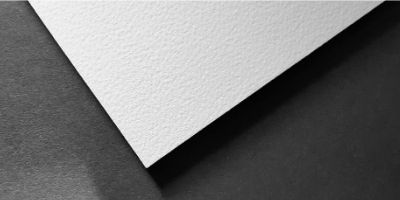
Cold-pressed watercolor paper or NOT paper is pressed through cylinders that are NOT hot. A good way to remember it is that it is NOT hot pressed.
The cold-pressed paper has some mid amount of texture. The amount of texture varies from brand to brand.
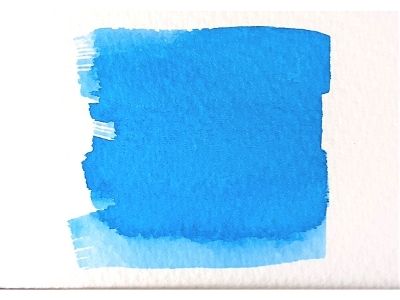
You can see the HP NOT paper covers the surface well but you can see some texture.
When to Use Cold Pressed Paper
Cold-pressed watercolor paper is the most popular paper choice for all kinds of watercolor painters. This is because it is the most flexible and easy to use. It is perfect for beginners and professionals alike.
- Cold-pressed watercolor paper has some texture so you can create textured techniques.
- It dries more quickly than HOT pressed however the small pockets of texture can stay wet. This allows more techniques and a fair amount of working time, but not too long.
- It is fine enough to do detail. Some botanical and architecture artists like some texture so will use this paper instead of hot-pressed.
Cold-pressed is the paper I’d recommended for beginners to watercolor for the above reasons. From here you can then try out rough or smooth depending on where your painting preference lies.
Artists’ own preference: I use cold-pressed (NOT) paper for most of my watercolor art. I like it because it is very flexible and has some texture but not too much. It gives me enough time to work but not too much.
I use it along with hot press for my botanicals. I also like to do architecture paintings with it. I know architecture artists like smooth paper but I like to freehand draw my architecture paintings because I love old-world buildings, cottages, and castles. Where I live there are lots of them. Texture suits the wonky style of buildings better in my view.
Use Rough Watercolor Paper For Texture
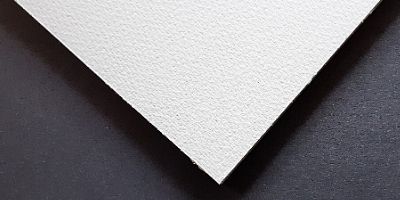
Rough watercolor paper has lots of texture. It is as its name implies rough. This paper has the most texture of the three paper types.
Rough paper is also pressed through rollers. These are mostly done with textured felt between the paper and the rollers. This is what makes the paper rough.
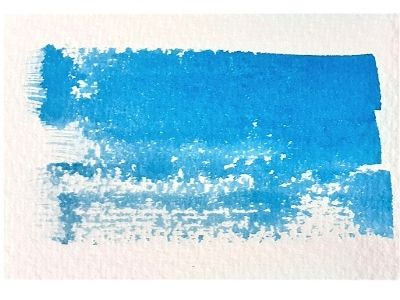
You can see the rough watercolor paper leaves more spaces and white gaps than the other two examples.
Rough Watercolor Paper Uses
- Rough watercolor paper is perfect for artists that like to do lots of dry watercolor techniques and love texture and graininess. If you like the effects of the cold-pressed textures it might be a good idea to try this as it enhances those effects.
- It isn’t very good for correcting nor lifting out the paint.
- It is not any good if you are artists that like lots of detail.
TIP: If you think you’d like to work on rough paper start with the cold-pressed paper to gain experience then swap over to this once you have a few techniques under your belt.
Artists’ own preferences: Up until recently I haven’t really used rough paper much as I prefer more detailed work Although, I am now experimenting with rough paper. I did see a paint a cat course recently that used rough paper. Rough paper is perfect for animal fur texture. But again I go for detail so would find it challenging.

What Watercolor Paper Weight Should You Use
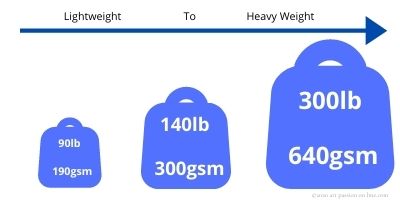
Watercolor paper comes in many different weights. It is measured in two ways either by the pound (lb) per *ream or grams per square meter (gsm).
*A ream is 500 sheets.
GSM is more accurate than LB. It isn’t really an issue when you are buying paper off the shelf as they are usually rounded up to standard weights.
The common popular weights for all the textures of paper are shown below.
- 90lb – 190gsm
- 140lb – 300gsm
- 300lb – 640gsm
There are many other weights but these are the ones most people use. Most brands create common weights. Some brands have completely different weights. If you know these weights you will know where the different ones stand in relation to these.
Watercolor sketchbooks can be a lighter weight paper for ease of use.
The weight of the paper is important. It makes a huge difference in how you can work. For example, lighter papers need to be stretched and heavy ones don’t. The way the paper absorbs water is different for different thicknesses.
The paper starts off lighter and thinner (90lb -190gsm) and works up to really thick almost like a board (much thicker than the 300lb – 640gsm paper).
90lb Lightweight Watercolor Paper
- This paper is thin and must be stretched (wetted and taped to a board) to prevent buckling (bending and warping of the paper).
- It does not take some of the more vigorous techniques that people use in watercolor.
- Lowest cost to buy
Medium Weight 140g (300gsm)
- This is by far the most popular weight paper for most people.
- It is sturdy enough to take vigorous watercolor techniques.
- Although it is usually stretched (more on that under styles of paper), it may not need to be stretched if you work more dry than wet.
- It does buckle under wet conditions but there are ways around this and it does not buckle as much as lighter papers.
- Mid-range price.
140 g (300 gsm) is the weight paper I recommend that you start with.
Heavyweight 300lb – 640gsm
- This paper is a really thick paper.
- While not quite board it is not so easy to bend.
- This paper does not need to be stretched.
- The most expensive to buy.
There are other ways to prevent bending than to buy thick paper. Thick paper is way more expensive to buy.
Artists own Preference: I prefer the thick paper because it doesn’t warp or bend as much. However, I use 140lb (300 gsm) paper which I buy in blocks as I prefer to get straight to my art and not have to stretch my paper and it’s not so expensive
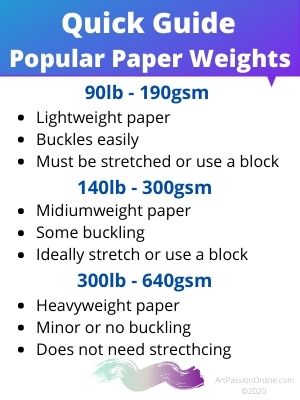
The Best Watercolor Paper Materials Cotton, Pulp or a Mixture
The materials you use when watercolor painting are vitally important. Unlike other types of painting, you can’t really get away with the cheaper painting surfaces.
If you are experienced you can transfer your skills to them. But as a beginner, it’s the death knell to your watercolor journey to buy cheaper paper. I know because it has been a stumbling block for me in the past.
It is difficult because you cannot assume that just because the materials are cheaper or more expensive they are the best quality either which is a pain.
I have spent hours researching what other artists feel about particular papers and why, as everyone is different.
There are different materials for watercolor paper.
- Pulp – Cellulose, incl, wood, Linen
- Cotton
- Cotton pulp mix
Pulp Papers
Cheaper or student grade watercolor papers are usually made from wood or other cellulose-based pulp. They vary greatly in price, quality, and usability.
Some higher quality papers are also cellulose based.
Cotton Papers
Cotton papers are made from 100% cotton. These are usually high quality more expensive papers. Although, I have seen some cheaper ranges.
The general consensus amongst most watercolor artists is that 100% cotton is the best surface to paint on. It improves your work a lot. It allows you to progress in your skill more quickly than you otherwise would have.
It is better quality, naturally free of acid and the paint works much better on cotton.
All artist quality watercolor paper should be acid-free as it is better quality and the artwork lasts longer.
The trouble is it is also the most expensive paper to buy. Which while is not a problem for some artists is a major stumbling block for many others. For one if you are afraid to use it you won’t be free to experiment and learn. Some people have expressed this concern.
Nor can you assume that all 100% cotton papers or even pulp papers are equal in quality or ability. Below I have gone through what you need to look out for in a quality paper.
Cotton Mixed Watercolor Papers
You can also get a mixture of the two with varying degrees of cotton. This gives you some of the advantages of cotton depending on the percentage in the paper.
Paper Quality
Paper quality plays a huge part in the outcome of your watercolor painting. While it’s true that an experienced watercolor artist can get good results on a cheaper paper and an expensive paper will not make you a master, it is vital to get the best paper you can.
Most artists recommend 100% cotton & acid free paper.
I’m usually not a big fan of brand names for the sake of brand names. However, when it comes to watercolor certain paper brands do equal quality. You do get what you pay for.
Better quality brands also mean that you can more easily use masking fluid to mask off white areas and remove it without damaging the paper or use magic erasers to lift off paint without leaving a stain. (Although this does also depend on paper type and material).
Artists Own Preference: I prefer to get 100% cotton if I can regardless of pressing because it works so beautifully. If I can’t, I get the highest quality pulp paper I can from a reputable brand. I do use the cheaper papers for my color samples as I use a lot of paper for them.
Top quality checklist for Watercolor Paper
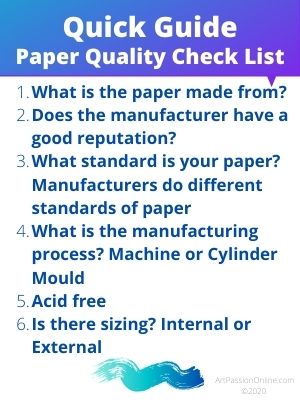
Each brand of paper is different. Even if you buy similar quality paper at a similar price across different brands the way it’s made will affect how it reacts to your painting techniques. So you cannot just swap brands and expect them to all behave the same. This makes brand recommendation difficult.
Style/Format of Watercolor Paper

You can buy watercolor paper in the following ways
- Loose sheets of paper
- Rolls of paper
- Pads Spiral & Fixed
- Blocks
- Art Boards
1. Loose sheets. You can buy watercolor paper in loose sheets. These come in different sizes.
This can be a cheaper way to buy your paper than in pads or blocks, but not always.
2. Rolls of paper. You can buy your paper in large rolls rather than sheets. These are used when you want to cut it to the size you want for your paintings. This may be because you want larger sizes or sizes you can’t get in the store.
- This seems to be more popular for professional use or for artists that do a lot of painting or and out of the box sizes.
- They are large and quite expensive to buy initially.
- They are also harder to store.
3. Watercolor Paper Pads Spiral & Fixed. Watercolor paper pads are simply a pad of watercolor sheets attached at one end either by rings, glue, or with a perforated line. Watercolor pads are by far the most popular way of buying your watercolor paper for most people.
- Watercolor pads are easy to obtain almost anywhere.
- They are very easy on the budget compared to rolls or blocks.
- Already pre-cut so you don’t have to worry about cutting.
- Available from most of the popular brands
Watercolor pads come in different sizes, textures, thickness and quality.
Say what size, quality, etc here remember to always say why they are used which to pick, etc as that is the question
When to use Watercolor Pads
Use watercolor pads at any time. They are great to use as small sketchbooks or to remove the paper for bigger projects. Use them if you have thick paper or if you want to take out sheets to stretch for thinner paper.
Most of the popular brands sell their paper this way in the main textures and sizes. It is just a convenient way to buy your paper. They are easier to store than sheets or rolls.
4. Blocks of Watercolor Paper

Watercolor paper blocks are blocks of watercolor paper sheets all glued together. They look like a pad. They are glued so that you can use them as they are and they do not buckle and bend like loose sheets of paper can. There may be mild buckling, and that will depend on the paper, the band, and how wet you make it. But it does straighten back out when it dries.
There is usually a small section that is left unglued so you can slip a knife in to separate the page from the block. I prefer to use something like a letter opener as that is not as sharp.
Choose Blocks
- If you want to use a thinner paper ie 140g
- And/or do not want to have it buckle or have to stretch it. I buy blocks for this reason as I prefer that than having to stretch the paper.
When Not To Choose Blocks if you want to do more than one picture at a time as it’s a pain because you cannot separate the sheets to start drawing or working on the next picture until you have fully finished the last one or have more than one block.
Blocks are a more expensive way to buy your paper than pads.
5. Watercolor Artboards. These are super thick boards with watercolor paper on them. You can either make your own or buy them ready to use. The board backing is to prevent the paper buckling when it is wet and the color seeping through to the other side.
When To Use Art Boards
Artboards are perfect if you want to paint outside or need transportable surfaces with little fuss. As they stop buckling it also means you do not have to wet the back or stretch the paper.
Artists Own preference: I use blocks as you can just get them out and use them, which is well worth the extra cost and savings in time in my view.
What Watercolor Paper Other Artists Use
Rather than just give you my opinion based on my experience I have also researched what watercolor artists use on YouTube, well-known art suppliers, and also asked 100s of artists from around the world which watercolor paper they use and why. The results were in some cases expected but in others surprising.
Without a doubt, the most popular paper across all brands of paper and the 4 countries I searched (UK, USA, Canada, India) was the 140lb 300gsm cold-pressed watercolor paper.
Artists criteria for paper choice include:
- Cost
- Quality
- Style or format – usability
- Availability
- Paper technical details
Cost
Some artists only use 100% cotton. Others use cheaper papers for practice and the cotton for their special work to keep costs down. While cost is a factor many consider that it is a false economy to buy cheaper papers as it is about quality and value rather than just expense.
Paper Quality
Artists go for the best quality they can afford. Most prefer the 100% cotton papers from well-respected manufacturers. However, some artists prefer the cheaper ranges for certain types of work or are happy with the cheaper ranges of paper. Cheaper is also used for practice work.
After all, if artists really did only get the 100% paper the other papers on the market would not exist as no one would be buying them.
Get Watercolor Paper
Most artists prefer to use proper watercolor paper and not mixed media paper or other paper as they are made especially for watercolor and the manufacturing process is quite different. You get the best results with watercolor paper. It’s easy to make sure you have the correct paper as it will say watercolor or mixed media on the pad or block. If using sheets or rolls just double-check the description.
Style Format & Preferences
The paper many artists get depends on their painting style. The more expensive cotton papers stay wet longer and allow better use of various techniques, including layering, blending, wet on wet and lifting, etc.
These are better for styles of art that are more detailed and realistic.
Cheaper or lower quality papers work well with line and wash which is not detailed and isn’t always layered. They are great for practicing and dry techniques
Not all artists get one with the way cotton works and prefer to use a quality brand of pulp paper instead.
Pros tend to use the 100% cotton watercolor papers of the highest quality.
Availability
While many of these paper brands are available around the world some are more readily available in some countries than others. Some of the brands are a lot more expensive in some countries than others depending on which country they started out from.
It may be that you can get an equally good quality paper locally that isn’t as popular worldwide as some of these well-known brands. Most artists go for the best brand they can that is available where they are base don many of the criteria I have covered here.
Which Manufacturing Process Is Best?
There are three different types of manufacturing of the papers
- machine
- mold
- handmade
It is best to get a mold-made watercolor paper.
Machine-made papers have a more consistent surface than the other two methods.
Handmade has an irregular surface.
Mold-made papers have a mix of the two types. This makes them perfect for most artists. Mid-range price.
Machine-made papers because they have a regular surface are not as tough as mold made and they can tear more easily. These are the cheapest.
Hand made is, of course, the ultimate but they are very expensive and most people are more than happy with mold-made watercolor paper.
The best quality brands do make their paper this way and pros will use mold-made paper for their work.
Sizing of Paper
The better quality papers are what is called size. This is a process where gelatin is added to the paper either internally or externally to help the paper stop water being absorbed too quickly.
Which Brand Of Watercolor Paper To Use?
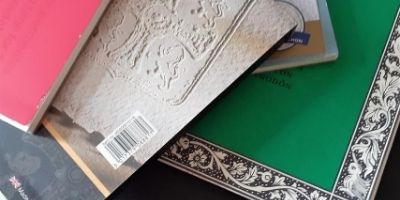
I have left brands of watercolor paper until last as I believe it is more important to know about the paper and then choose your brand.
While many of the popular brands are available across the world I don’t think it fair on my readers to simply say one particular brand as either the brands aren’t available or are too expensive in their countries. Better that you know the paper first so you can choose the best brand for you and what’s available near to you. Unless of course, you want to order from abroad.
Arches paper is highly recommended by most artists. It is also considered one of the most expensive papers and although widely available you can’t always get it everywhere. Although it is excellent I do not believe Arches is always the best or only choice.
As this article is getting a tad too long so I have gone into brands separately.
